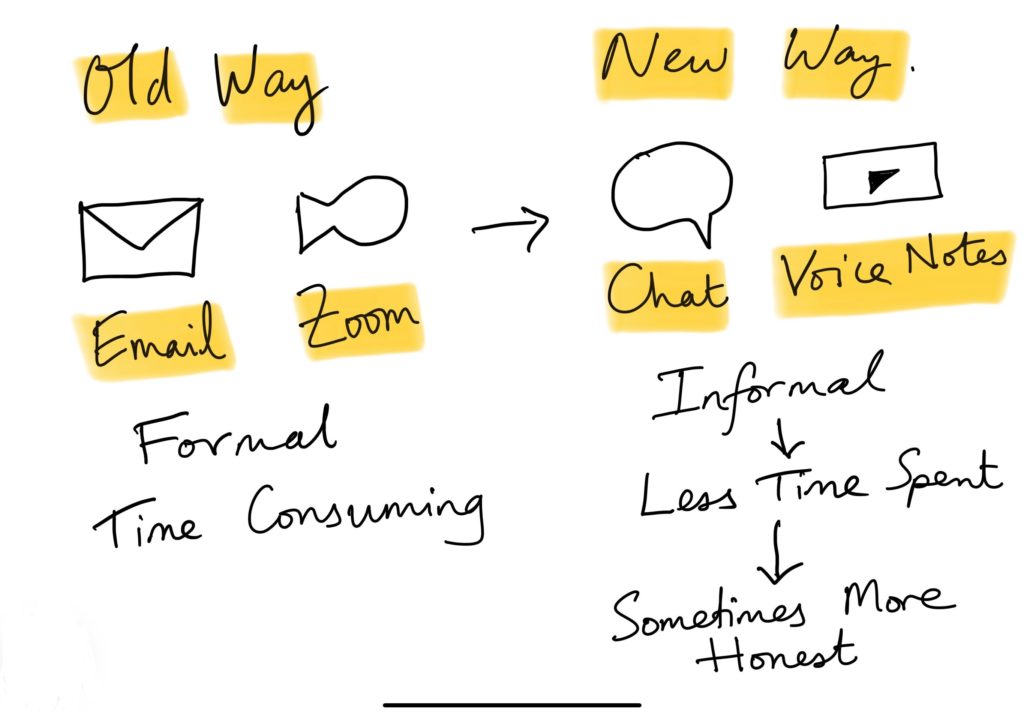In every workplace, from the smallest start-up to the largest multinational corporation, a pattern emerges. It’s the endless chain of emails that fill inboxes by the hour. It’s the back-to-back Zoom calls that stretch into late afternoons. And yet, there’s a subtle, unspoken fatigue growing beneath it all. The truth is, we’ve become prisoners to the very tools designed to make us more efficient. But what if the solution wasn’t adding more meetings or writing longer emails, but rather embracing something simpler, faster, and more personal?
A Missed Opportunity
The world has adopted email and video conferencing as default modes of communication. It’s understandable. Email is fast, it leaves a paper trail, and it feels safe. Zoom, on the other hand, replicates the face-to-face meeting in a world where offices are often thousands of miles apart. Yet, for all their benefits, both of these tools have significant drawbacks.
Think about Sarah, a team leader at a mid-sized consultancy. She starts her day sifting through an inbox overflowing with requests. “Can we meet at 2 p.m. to discuss the project?” or “Here’s a document—let me know your thoughts by end of day.” A steady drip of communication that feels never-ending. When the clock hits 2 p.m., she’s deep into Zoom calls. Some productive, others redundant. She ends her day tired, not from the work itself, but from the tools she used to manage it.
Now, imagine if Sarah’s colleague, James, hadn’t sent her that 2 p.m. Zoom invite but instead recorded a quick 2-minute voice note. He explains his thoughts clearly, provides a couple of updates, and leaves room for her to respond at her convenience. Sarah, while on her commute home, listens, quickly records a response, and moves on. No meeting, no inbox anxiety, just quick, effective communication.

The Hidden Power of Voice
Voice is the oldest form of communication, yet in the professional world, we seem to have abandoned it. But there’s something powerful in hearing someone speak—something email can never replicate. It’s the subtle cues, the inflection, the emphasis, the human connection.
Let’s take a moment to think about James and his team. They used to spend 20 minutes every morning on a Zoom call discussing progress. But one day, James made a simple shift. Instead of booking a meeting, he sent out a voice note in the group chat: “Morning team, just a quick update on where we are. I think we’re progressing well on the Johnson account, but let’s tighten up on the deadline for the audit. Feel free to send over any blockers by voice note if you encounter them.”
That morning, something shifted. The team, no longer shackled to their desks, sent their replies while walking to grab coffee or taking a break outside. Instead of sitting in front of their screens, they were moving, thinking, and communicating fluidly. By the time 9:30 a.m. rolled around, they’d all received the same information—just without the need to set aside time for a formal meeting.
Redefining Communication at Work
This isn’t just about making things more convenient. It’s about changing the very nature of workplace communication. By incorporating voice notes, we’re not only saving time but also unlocking new efficiencies. Consider this—when you type out an email, you second-guess your words, you reread, you rewrite. But when you speak, you allow your natural thought process to unfold, often getting your point across faster, with less friction.
Voice notes also allow for spontaneity and creativity. Picture a creative team brainstorming ideas for a new campaign. In a Zoom call, there’s often a pressure to contribute in real time. But with voice notes, people can leave their thoughts as they come to them, in bursts of inspiration. One team member might leave a note in the afternoon, sparking an idea in another who listens later that evening, adding their thoughts. By the time they regroup, the idea has evolved organically without needing a single scheduled meeting.
Real Change Starts with Leadership
Of course, adopting voice notes as a regular form of communication takes a cultural shift. It requires leaders to embrace the change first. One manager at a software company in Leeds did exactly that. Frustrated by the time spent in endless email chains, she began leaving voice notes for her team instead. “At first, I worried people would be hesitant. But it was the opposite—they loved it. Our team chat is filled with these little moments of insight, shared quickly and efficiently. We’ve cut our meeting times in half.”
Leaders, by setting the example, show their teams that this mode of communication is not only acceptable but preferred. It’s about creating a new norm where we trust each other to be both efficient and thoughtful.
The Path Forward
In a world where work is increasingly digital, we’ve grown too accustomed to tools that keep us tethered to our screens. Email, for all its usefulness, has turned into a burden. Zoom, though it connects us visually, can drain us of the energy needed for creative, spontaneous work. But voice notes—these bite-sized bursts of communication—offer us a third way. They remind us that efficiency doesn’t always mean more meetings or more emails. Sometimes, it’s about saying what you need to say, in your own voice, and trusting that it will be heard.
Just as Sarah found herself freed from Zoom fatigue, and James discovered a new rhythm for his team, we too can unlock the potential of our own voices. It’s time we stopped defaulting to the tools we’ve always used and started thinking about what’s truly effective. Because, in the end, a well-placed voice note may just be the communication revolution we didn’t know we needed.
